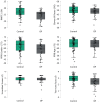Both identity and non-identity face perception tasks predict developmental prosopagnosia and face recognition ability
- PMID: 38503841
- PMCID: PMC10951298
- DOI: 10.1038/s41598-024-57176-x
Both identity and non-identity face perception tasks predict developmental prosopagnosia and face recognition ability
Abstract
Developmental prosopagnosia (DP) is characterised by deficits in face identification. However, there is debate about whether these deficits are primarily perceptual, and whether they extend to other face processing tasks (e.g., identifying emotion, age, and gender; detecting faces in scenes). In this study, 30 participants with DP and 75 controls completed a battery of eight tasks assessing four domains of face perception (identity; emotion; age and gender; face detection). The DP group performed worse than the control group on both identity perception tasks, and one task from each other domain. Both identity perception tests uniquely predicted DP/control group membership, and performance on two measures of face memory. These findings suggest that deficits in DP may arise from issues with face perception. Some non-identity tasks also predicted DP/control group membership and face memory, even when face identity perception was accounted for. Gender perception and speed of face detection consistently predicted unique variance in group membership and face memory; several other tasks were only associated with some measures of face recognition ability. These findings indicate that face perception deficits in DP may extend beyond identity perception. However, the associations between tasks may also reflect subtle aspects of task demands or stimuli.
© 2024. The Author(s).
Conflict of interest statement
The authors declare no competing interests.
Figures



Similar articles
-
Normal gaze processing in developmental prosopagnosia.Cortex. 2022 Sep;154:46-61. doi: 10.1016/j.cortex.2022.05.011. Epub 2022 Jun 2. Cortex. 2022. PMID: 35749966
-
Dissociations between face identity and face expression processing in developmental prosopagnosia.Cognition. 2023 Sep;238:105469. doi: 10.1016/j.cognition.2023.105469. Epub 2023 May 20. Cognition. 2023. PMID: 37216847
-
Face specific inversion effects provide evidence for two subtypes of developmental prosopagnosia.Neuropsychologia. 2022 Sep 9;174:108332. doi: 10.1016/j.neuropsychologia.2022.108332. Epub 2022 Jul 14. Neuropsychologia. 2022. PMID: 35839963
-
The cognitive and neural basis of developmental prosopagnosia.Q J Exp Psychol (Hove). 2017 Feb;70(2):316-344. doi: 10.1080/17470218.2016.1165263. Epub 2016 Apr 27. Q J Exp Psychol (Hove). 2017. PMID: 26967836 Review.
-
Electrophysiological studies of face processing in developmental prosopagnosia: neuropsychological and neurodevelopmental perspectives.Cogn Neuropsychol. 2012;29(5-6):503-29. doi: 10.1080/02643294.2012.716757. Epub 2012 Oct 16. Cogn Neuropsychol. 2012. PMID: 23066851 Review.
Cited by
-
Improving the DSM-5 approach to cognitive impairment: Developmental prosopagnosia reveals the need for tailored diagnoses.Behav Res Methods. 2024 Oct;56(7):7872-7891. doi: 10.3758/s13428-024-02459-4. Epub 2024 Jul 8. Behav Res Methods. 2024. PMID: 38977608 Free PMC article.
References
MeSH terms
LinkOut - more resources
Full Text Sources

